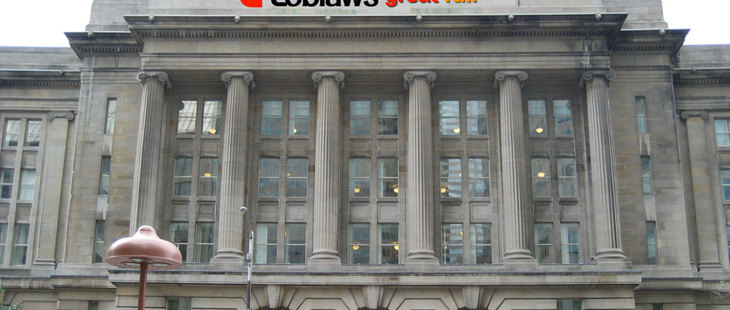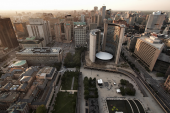
It’s understandable that the locals might be unnerved at the advance of corporate naming, especially now that renaming subway stations is on the table. It’s almost as unnerving as the ongoing question about whether man can devise a festival, initiative or abstract concept that Scotiabank will not somehow brand.
The idea of selling naming rights has found its most florid expression, unsurprisingly enough, in Doug Ford, the mayor’s brother. Doug’s exact role at city hall is nebulous, but it seems to involve trotting out crazy ideas that can be run up the flagpole and then plausibly denied. The latest: That Spadina station might be renamed “McDonalds Spadina” station.
You have to give the man some credit. Doug must have known that, by targeting subway stations, he was dripping steak sauce on a sacred cow. The idea seems to far-fetched and so anathema to the liberal mind that it’s been the stuff of satire from the moment it was mooted. In these same pages, Tabatha Southey predicted that we’d end up in a city called the Toronto and Firkin.
Around the Internet, you can hear the lament of the public-space advocate. They make compelling arguments: The unrelenting march of corporate naming rights devalues the public realm. It erodes the idea that there’s any space in the city that’s by the people, for the people. It calls into question the notion that a city can do anything simply because its citizens decide that they want to pool their resources and do something for their own betterment, without corporate involvement.
Fair enough. But these objections are also the expression of a certain allergic reaction to private branding, especially when it’s espoused by such notable allergens as Rob and Doug Ford. Moreover, the limits of what the public accepts in the way of branding is riddled with inconsistencies. So many of the places and icons beloved of public-space enthusiasts are privately-branded through and through, though the patina of age give their names a patina of familiarity.
It is well, for instance, that the CN Tower is not named after a railroad, which would spoil its appeal those amongst the general public not wearing stripy little engineers hats. Similarly, I’m glad on a daily basis that the Eaton Centre is not named for a department store, which would have left me feeling alienated while browsing the department store it contains. (Actually, this is a lie. Nobody browsed at Eatons, which may explain why it’s now Sears, and Sears is just a thing you walk through on your way to the Apple Store.)
I pine for the days before the Leafs played at the Air Canada Centre, back before they let the money-changers into the temple of hockey. Maple Leaf Gardens, after all, was merely named for one nakedly commercial enterprise, instead of the debasement of giving one nakedly commercial enterprise the naming rights to a building housing another.
I yearn for the days when the Rogers Centre was the SkyDome, a name that united Torontonians by reminding them of their bond as taxpayers on the hook for a publicly-funded debacle. And I’m perennially grateful that Santiago Calatrava popped by to build the galleria at Brookfield Place, what with the heap tree-like structural steel that had been piling up in his backyard that he couldn’t seem to get rid of.
It’s not useful to get too sanctimonious about locations named for individuals, either. Industrialist philanthropists were the corporate sponsors of yesteryear. Like the Carnegies and Rockefellers of the world, Hart Massey, he of the House and the Hall, was a magnate who didn’t mind seeing his personal brand (a new term for an old idea) burnished by public buildings named in his honour.
Similarly, many roads were named for the owners of the land they carved through, or for suitably rich and suitably dead members of the aristocracy, or for businesspeople involved in their creation. Asa Danforth was a road contractor, after all.
It’s the passage of the years that confers a sense of public ownership to these names. But the fact that we’re forgetful doesn’t change the fact that there was lucre, filthy and not, at their origin.
In fact, if we’re going to be purists about public space, then let us retreat from our policy of selling the naming rights to everything and instead name nothing. Stop selling out, and join my movement — the anabrandists! — in which publicly-frequented spaces are given only functional descriptions. What better way to promote the public sphere then by making sure that no brands, individuals or vested interests are promoted by having their names aired in public?
For instance, after you’ve seen the glass floor atop the Toronto Regional Pointy Thing, which towers over the Retractable Sporting Loseatorium (not to be confused with the Non-Retractable Sporting Loseatorium, just east along Inexplicably Curvy Suburban Blvd.), you can cross the railroad tracks, pass by the red-and-blue headquarters of We Rebroadcast American Shows With Public Money and proceed to buy some housewares at Honest Small Crap Retailer’s department store. Heading east, cross the Large Jumping-Proof Viaduct until you reach Ethnic Zone Q, where you might enjoy a meal delivered from a Toronto A La Cart buggy.
If you think this prospect is totally untethered, might I remind you that France recently banned most televised mentions of Facebook and Twitter for strikingly similar reasons.
But the reality that France rails against is a positive fact of our society: Commerce is culture. Private places become public spaces. Tim Hortons is more Canadian than moose. The Eaton Centre is Toronto, as much or more than Kensington Market.
Selling naming rights to subway stations won’t be as lucrative as the Fords seem to think it will be, and is probably inadvisable on the grounds of international ridicule. But haven’t we already started down that path already, by dressing up Museum Station as if it were the ROM’s gift shop? (The other day, infuriatingly, it popped up on a list of the world’s coolest subway stations.) Hasn’t Cinnabon already secured the nasal branding rights to Eglinton station? And does anybody not think of Dundas West Station as Dundas West McDonalds Station?
Toronto was not built as a people’s utopia. Nor are its publicly-named spaces a fragile wetland habitat for civic virtue. Toronto is a mercantile town tempered with strong civic instincts, and yes, the two need to be kept in balance.
But our grand public spaces have always been built by a grand sloshing-together of public and private money. That mix will continue to find new expressions. Our civic instincts will persist. Even if from now on they’re to be referred to as Scotiabank Presents Toronto’s Civic Instincts.















